

For example, Hindi and Urdu are very similar and belong to the same language family (Indo-European). Hindi uses a writing system based on the extinct language Sanskrit (Devanagari), whereas Urdu writing uses the Nastaliq script derived from Arabic. Similarly, Croatian and Serbian use the Latin and Cyrillic alphabets respectively even though the two languages are very closely related.
Conversely, many unrelated languages may use the same alphabet. Languages that use the Latin Alphabet include English, Malay, Quechua, Swahili, Hungarian, Vietnamese, and Turkish; all of these belonging to different families.
A few languages have their own unique scripts. Examples include Armenian, Amharic, Tamil, Korean, and Mongolian.
The major systems are Hieroglyphs (picture writing used by Ancient Egyptian), Mayan Glyphs (drawings representing words) and Cuniform (wedge shaped characters used by Sumerian, Babylonian, Assyrian, Hittite and Persian) are examples that are no longer used. The modern languages of China (for example, Mandarin, Cantonese) and Japanese are still written useing logograms called Chinese Characters.
In Chinese writing each character denotes an idea or complete word. The character has a meaning but gives no clue to the pronunciation. The meaning can be inferred by a speaker of Cantonese or Mandarin even though each would pronounce the character in a different way. It is a little like the symbol 3 which is pronounced three (English), tres (Spanish), ooch (Turkish), sam (Thai) or teen (Hindi). However it is pronounced, it means the number between two and four.
Chinese writing requires the use and knowledge of thousands of separate characters.
By far the most common writing systems in the world are based on symbols determined by sounds rather than words. In an Alphabet, each symbol represents a single sound (for example P, K, A). In a Syllabary each symbol represents a simple combination of sounds (for example KA, DI, LO). With these systems, far fewer symbols are required.
The alphabet was invented in Ugarit (in the modern country of Syria) during the 2nd Millennium BC. This Ugarit Alpahbet was derived from a previous Cuniform writing system. The original alphabet was invented by Semitic peoples and only contained consonants. To make it easier to remember the symbols, they were taken from words beginning with the sound represented.
For example 'aleph is a Semitic word meaning ox and is a glottal stop - like the way a Londoner would pronounce the TT in bottle. Beth (for B) means house, gimmel (soft G - camel), daleth (D - door), etc. With minor variations this original alphabet has evolved to all the modern scripts in the world, even down to the sequence of the letters.
The Ugarit Alphabet slowly evolved into the Phonoecian, alphabet of the Mediterranean region. This evolved into Hebrew (via Aramaic) and Arabic (via Nabatean), both within the area of its invention. The Arabic script spread with Islam and was adapted for use by other languages. The Nastaliq form of Arabic is used by Urdu and Farsi. Maldivian and Syriac also use adaptaions from Arabic. These scripts generally only have symbols for consonants. Vowels are generally represented by various additional symbols over or below the consonants.
Moving West from its area of origin, the Phoenician alphabet spread to Carthage as the Punic Alphabet.
Phonoecian was also adapted to form the Greek Alphabet. This was the first alphabetic system to use symbols for vowels. The semitic gutteral stop, 'aleph, which did not occur in Greek became used for the Greek alpha (representing the vowel A).
Greek was adopted by the Etruscans and adapted for their alphabet and from there became the Latin alphabet of the Roman Empire. The letters were A, B, C (from the original Semitic G sound which the Etruscans had changed to a hard C), D, E, F (another Etruscan invention), G (derived from the shape of the C), H, I, K, L, M, N, O, P, Q, R, S, T, V (which was used for the sounds of modern U and W), X, Y, Z. The letters Y and Z were near the beginning of the Greek alphabet. They were dropped from the original Latin alphabet and then re-added at the end.
The Latin alphabet has now spread around the world to such an extent that many people refer to it as the alphabet. It is the alphabet used by the Americas (even for indigenous languages which were not previously written, for example: Quechua, Guarani), Western Europe, Africa (where it was taken by Europeans and is now used by languages such as Swahili and Xhosa), and a few areas in Asia (by languages like Vietnamese, Malay, Tagalog).
During the Middle Ages, the letter I split into two forms (the modern I and J) while V split into U, V and W. Many modern languages that use the Latin script use extra forms of these letters (like Ñ, Ü, É).
The Cyrillic alphabet is based on Greek and Latin and is found in much of Eastern Europe amongst Orthodox Christian areas (Russian, Bulgarian, Serbian). The Egyptian Coptic script, Armenian and Georgian are also based on Greek.

The alphabet also moved East when Aramaic moved to Central Asia to give the Mongolian script and arrived in North India as Brahmi. This become the syllabaries of North Indian languages like Hindi, Bengali, Punjabi and Gujerati. Tibetan script derives from the North Indian systems.
The North Indian Syllabaries have a symbol for consonants with a built-in short a (Ba, La, Ka, Da, etc). A further symbol is added to change the built-in vowel (for example Ba to BA, Ba to BE, Ba to Bi, etc).
In Southern India, the North Indian syllabaries evolved into the curved syllabaries of languages like Pali, Tamil, and Singhalese (in Sri Lanka). The spread of Buddhism to South East Asia took these curved scripts further east (Burmese, Thai, Khmer, and Javanese). These scripts were originally written on palm leaves which split if a straight line is drawn on them. These scripts therefore developed a curved appearance.
The Aramaic alphabet also went south from its area of origin to Ethiopia to yield the script for Amharic.
Alphabets and syllabaries are now used for all written languages apart from Chinese Characters used in China and Japan. Japanese uses two other writing systems (both syllabaries) alongside the Chinese characters. Korean stopped using Chinese Characters during the 14th Century AD when it developed its own alphabet. Even in China, a Latin alphabet is used to help foreigners navigate around cities.

OmniGlot
An excelent archive of scripts.

| Click on the ISBN Number to go straight to the book. | COM |
Co UK |
| Writing Systems of the World lists and describes all the world's scripts, past and present. |
|
|